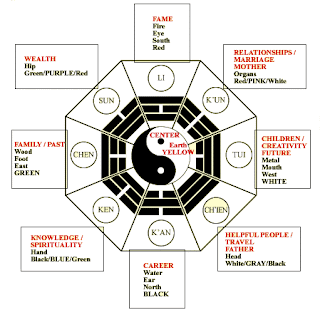A friend of mine has recently divorced her husband of twelve
years and seems to be going through a stage that at first I found mildly
alarming but now I am kind of intrigued by. All of a sudden she is into
everything alternative and I am simply hypnotised listening to her tales. This
lady who has led a rather average lifestyle for over a decade has now become
vegan, signed up for a charity skydive, had reiki healing, is learning about
how crystals influence our lives and most recently had a Feng Shui master round to Feng Shui her
house.
Now most of this stuff I can take or leave, but Feng Shui is
something that has always interested me so I listened intently as she told me
about moving furniture around, adding layered lighting and throwing out some of
her wall hangings. I didn’t want to let
her know but I was totally intrigued and really wanted to find out more, in
fact I really wanted to have a go myself. But as I had been slightly critical
of my friends new approach to life, I might at one stage have called her an
aging hippie with a mid-life crisis, I felt I couldn’t really tell her I was
going to try Feng Shui. So what to do?
Lightbulb moment… I’ll Feng Shui my bedroom and then she
will never know. Genius! It is also the most run down and unappealing room in
the house with lacklustre lighting, a third hand bed that is falling to pieces
and rather drab pictures on the wall. I knew I was going to have to start from
scratch to achieve good Feng Shui as my room lacked any sort of energy, let
alone positive energy and had a proper clear out before beginning, clutter is
definitely bad for the energy flow.
So, the first step was to clear the furniture and look
online for a decent looking bed and two bedside tables, it is important to have
two as this balances the energy around the bed.
If you’re looking at your own furniture and thinking it could use a
facelift then see the
bedroom furniture range here that is on offer at David Phillips. A great
range and lots of simple lines that are great for the Feng Shui energy.
Next were the images on my walls. For good Feng Shui you are
meant to display only images that you want to see happening in your life; I
chose a calm sky scene with a hot air balloon rising above the clouds. Lastly,
I had to sort out the lighting and colour flow in the room as well as the air
quality. The potted plants on my sideboard were out and the air dehumidifier in
and then I added a dimmer switch to the main light and well placed coloured
lamps. Voila, my new room is complete and it looks great. Does it give me
better energy, who knows but I’m certainly a happier girl sleeping in my newly
decorated boudoir!



